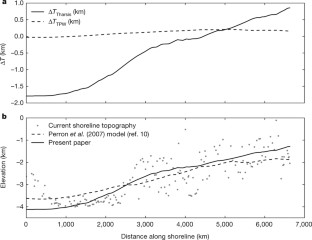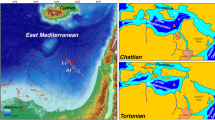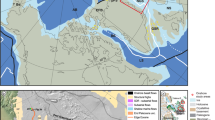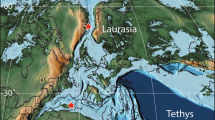Abstract
Widespread evidence points to the existence of an ancient Martian ocean1,2,3,4,5,6,7,8. Most compelling are the putative ancient shorelines in the northern plains2,7. However, these shorelines fail to follow an equipotential surface, and this has been used to challenge the notion that they formed via an early ocean9 and hence to question the existence of such an ocean. The shorelines’ deviation from a constant elevation can be explained by true polar wander occurring after the formation of Tharsis10, a volcanic province that dominates the gravity and topography of Mars. However, surface loading from the oceans can drive polar wander only if Tharsis formed far from the equator10, and most evidence indicates that Tharsis formed near the equator11,12,13,14,15, meaning that there is no current explanation for the shorelines’ deviation from an equipotential that is consistent with our geophysical understanding of Mars. Here we show that variations in shoreline topography can be explained by deformation caused by the emplacement of Tharsis. We find that the shorelines must have formed before and during the emplacement of Tharsis, instead of afterwards, as previously assumed. Our results imply that oceans on Mars formed early, concurrent with the valley networks15, and point to a close relationship between the evolution of oceans on Mars and the initiation and decline of Tharsis volcanism, with broad implications for the geology, hydrological cycle and climate of early Mars.
This is a preview of subscription content, access via your institution
Access options
Access Nature and 54 other Nature Portfolio journals
Get Nature+, our best-value online-access subscription
$29.99 / 30 days
cancel any time
Subscribe to this journal
Receive 51 print issues and online access
$199.00 per year
only $3.90 per issue
Buy this article
- Purchase on Springer Link
- Instant access to full article PDF
Prices may be subject to local taxes which are calculated during checkout



Similar content being viewed by others
References
Baker, V. R . et al. Ancient oceans, ice sheets and the hydrological cycle on Mars. Nature 352, 589–594 (1991)
Parker, T. J., Saunders, R. S. & Schneeberger, D. M. Transitional morphology in West Deuteronilus Mensae, Mars: implications for modification of the lowland/upland boundary. Icarus 82, 111–145 (1989)
Parker, T. J., Gorsline, D. S., Saunders, R. S., Pieri, D. C. & Schneeberger, D. M. Coastal geomorphology of the Martian northern plains. J. Geophys. Res. Planets 98, 11061–11078 (1993)
Head, J. W. et al. Possible ancient oceans on Mars: evidence from Mars Orbiter Laser Altimeter data. Science 286, 2134–2137 (1999)
Di Achille, G. & Hynek, B. M. Ancient ocean on Mars supported by global distribution of deltas and valleys. Nat. Geosci. 3, 459–463 (2010)
Clifford, S. M. & Parker, T. J. The evolution of the Martian hydrosphere: implications for the fate of a primordial ocean and the current state of the northern plains. Icarus 154, 40–79 (2001)
Carr, M. H. & & Head, J. W. Oceans on Mars: an assessment of the observational evidence and possible fate. J. Geophys. Res. Planets 108, 5042 (2003)
Rodriguez, J. A. P. et al. Tsunami waves extensively resurfaced the shorelines of an early Martian ocean. Sci. Rep. 6, 25106 (2016)
Malin, M. C. & Edgett, K. S. Oceans or seas in the Martian northern lowlands: high resolution imaging tests of proposed coastlines. Geophys. Res. Lett. 26, 3049–3052 (1999)
Perron, J. T., Mitrovica, J. X., Manga, M., Matsuyama, I. & Richards, M. A. Evidence for an ancient martian ocean in the topography of deformed shorelines. Nature 447, 840–843 (2007)
Willemann, R. J. Reorientation of planets with elastic lithospheres. Icarus 60, 701–709 (1984)
Roberts, J. H. & Zhong, S. The cause for the north-south orientation of the crustal dichotomy and the equatorial location of Tharsis on Mars. Icarus 190, 24–31 (2007)
Daradich, A. et al. Equilibrium rotational stability and figure of Mars. Icarus 194, 463–475 (2008)
Matsuyama, I. & Manga, M. Mars without the equilibrium rotational figure, Tharsis, and the remnant rotational figure. J. Geophys. Res. Planets 115, E12020 (2010)
Bouley, S. et al. Late Tharsis formation and implications for early Mars. Nature 531, 344–347 (2016)
Kite, E. S ., Matsuyama, I., Manga, M ., Perron, J. T. & Mitrovica, J. X. True Polar wander driven by late-stage volcanism and the distribution of paleopolar deposits on Mars. Earth Planet. Sci. Lett. 280, 254–267 (2009)
Anderson, R. C. et al. Primary centers and secondary concentrations of tectonic activity through time in the western hemisphere of Mars. J. Geophys. Res. Planets 106, 20563–20585 (2001)
Ivanov, M. A., Erkeling, G., Hiesinger, H., Bernhardt, H. & Reiss, D. Topography of the Deuteronilus contact on Mars: evidence for an ancient water/mud ocean and long-wavelength topographic readjustments. Planet. Space Sci. 144, 49–70 (2017)
Dohm, J. M., Baker, V. R ., Maruyama, S. & Anderson, R. C. In Superplumes: Beyond Plate Tectonics 523–536 (Springer, 2007)
Rouby, H., Greff-Lefftz, M. & Besse, J. Rotational bulge and one plume convection pattern: influence on Martian true polar wander. Earth Planet. Sci. Lett. 272, 212–220 (2008)
Smith, D. E., Zuber, M. T., Neumann, G. A., Guinness, E. A. & Slaveny, S. Mars Global Surveyor Laser Altimeter mission experiment gridded data record. MGS-M-MOLA-5-MEGDR-L3–V1.0, http://pds-geosciences.wustl.edu/missions/mgs/megdr.html (NASA Planetary Data System, 2003)
Ruiz, J ., Tejero, R ., Gómez-Ortiz, D. & López, V. in Space Science: New Research 141–164 (Nova Science, 2006)
Grott, M. & Breuer, D. On the spatial variability of the Martian elastic lithosphere thickness: evidence for mantle plumes? J. Geophys. Res. Planets 115, E03005 (2010)
Roberts, J. H. & Zhong, S. Plume-induced topography and geoid anomalies and their implications for the Tharsis rise on Mars. J. Geophys. Res. Planets 109, E03009 (2004)
Ruiz, J., Fairén, A. G., Dohm, J. M. & Tejero, R. Thermal isostasy and deformation of possible paleoshorelines on Mars. Planet. Space Sci. 52, 1297–1301 (2004)
Davila, A. F. et al. Evidence for Hesperian glaciation along the Martian dichotomy boundary. Geology 41, 755–758 (2013)
Edgett, K. S. & Parker, T. J. Water on early Mars: possible subaqueous sedimentary deposits covering ancient cratered terrain in western Arabia and Sinus Meridiani. Geophys. Res. Lett. 24, 2897 (1997)
Kite, E. S. et al. Methane bursts as a trigger for intermittent lake-forming climates on post-Noachian Mars. Nat. Geosci. 10, 737–740 (2017)
Costard, F. et al. Modeling tsunami propagation and the emplacement of thumbprint terrain in an early Mars ocean. J. Geophys. Res. Planets 122, 633–649 (2017)
Halevy, I. & Head, J. W. Episodic warming of early Mars by punctuated volcanism. Nat. Geosci. 7, 865–868 (2014)
Tian, F. et al. Photochemical and climate consequences of sulfur outgassing on early Mars. Earth Planet. Sci. Lett. 295, 412–418 (2010)
Pan, L., Ehlmann, B. L., Carter, J. & Ernst, C. M. The stratigraphy and history of Mars’ northern lowlands through mineralogy of impact craters: a comprehensive survey. J. Geophys. Res. Planets 122, 1824–1854 (2017)
Halevy, I., Zuber, M. T. & Schrag, D. P. A sulfur dioxide climate feedback on early Mars. Science 318, 1903–1907 (2007)
Harada, Y. Long-term polar motion on a quasi-fluid planetary body with an elastic lithosphere: semi-analytic solutions of the time-dependent equation. Icarus 220, 449–465 (2012)
Chan, N.-H. et al. Time-dependent rotational stability of dynamic planets with elastic lithospheres. J. Geophys. Res. Planets 119, 169–188 (2014)
Hu, H., van der Wal, W. & Vermeersen, L. L. A. A full-Maxwell approach for large angle polar wander of viscoelastic bodies. J. Geophys. Res. Planets 122, 2745–2764 (2017)
Moore, K. M., Chan, N.-H., Daradich, A. & Mitrovica, J. X. Time-dependent rotational stability of dynamic planets with viscoelastic lithospheres. Icarus 289, 34–41 (2017)
Sjogren, W. L. Mars gravity: high-resolution results from Viking Orbiter 2. Science 203, 1006–1010 (1979)
Zuber, M. T. et al. Internal structure and early thermal evolution of Mars from Mars Global Surveyor topography and gravity. Science 287, 1788–1793 (2000)
Searls, M. L., Banerdt, W. B. & Phillips, R. J. Utopia and Hellas basins, Mars: twins separated at birth. J. Geophys. Res. Planets 111, E08005 (2006)
McGowan, E. M. & McGill, G. E. Anomalous tilt of Isidis Planitia, Mars. Geophys. Res. Lett. 33, L08S06 (2006)
Fairén, A. G. A cold and wet Mars. Icarus 208, 165–175 (2010)
Werner, S. C. & Tanaka, K. L. Redefinition of the crater-density and absolute-age boundaries for the chronostratigraphic system of Mars. Icarus 215, 603–607 (2011)
Tanaka, K. L., Robbins, S. J., Fortezzo, C. M., Skinner, J. A. & Hare, T. M. The digital global geologic map of Mars: chronostratigraphic ages, topographic and crater morphologic characteristics, and updated resurfacing history. Planet. Space Sci. 95, 11–24 (2014)
Spada, G. ALMA, a Fortran program for computing the viscoelastic Love numbers of a spherically symmetric planet. Comput. Geosci. 34, 667–687 (2008)
Arkani-Hamed, J. The lunar mascons revisited. J. Geophys. Res. Planets 103, 3709–3739 (1998)
Acknowledgements
We thank J. T. Perron for providing the data for the Arabia shoreline (originally from ref. 7), and M. A. Ivanov for providing the data for the Deuteronilus and Isidis shorelines. We thank I. Matsuyama for discussions regarding this research. R.I.C. and M.M. are supported by NSF EAR-1135382. D.J.H. is supported by the Miller Institute for Basic Research in Science.
Author information
Authors and Affiliations
Contributions
All authors discussed the research idea, methods and interpretation of results. R.I.C. and M.M. developed the hypothesis with input from D.J.H. R.I.C. performed the calculations and wrote the manuscript, with guidance, comments, and revisions from M.M. and D.J.H.
Corresponding author
Ethics declarations
Competing interests
The authors declare no competing financial interests.
Additional information
Reviewer Information Nature thanks S. Bouley and M. Zuber for their contribution to the peer review of this work.
Publisher's note: Springer Nature remains neutral with regard to jurisdictional claims in published maps and institutional affiliations.
Extended data figures and tables
Extended Data Figure 1 Illustration of the feasibility of post-Tharsis TPW depending on the location of Tharsis’ formation.
a–c, Tharsis (orange zone) forms far from the palaeo-equator (a), causing large-scale TPW as the planet reorients so Tharsis is at the equator (b). After the reorientation, the fossil bulge is far from the current equatorial bulge, making the rotation pole sufficiently unstable to allow for ocean loading (blue zone) to cause subsequent TPW along an arc 90° from Tharsis (c, blue dashed line)10. d–f, Alternatively, Tharsis forms near the palaeo-equator (d), causing limited (approximately 20°) TPW (e). The position of the fossil bulge near the equator stabilizes the planet against subsequent TPW caused by oceans and other surface loads (f, see supplementary figure 1 of ref. 10). Formation of Tharsis near the equator is supported by refs 14 and 15.
Extended Data Figure 2 Map of shoreline locations, MOLA topography, and Tharsis deformation.
Arabia (magenta) shoreline data are from ref. 10 (data originally from ref. 7). Deuteronilus (white) and Isidis (cyan) shoreline data and regional names are from ref. 18. The contribution of Tharsis to Mars’ topography up to degree-5 (equation (2)) is displayed as 1-km dark grey contours (dashed contours are negative).
Extended Data Figure 3 Effect of elastic lithosphere thickness on deformation due to Tharsis.
a, Current Arabia shoreline topography compared to displacement due to TPW and Tharsis deformation (equation (3)). Tharsis gravity and shape coefficients are computed separately for Te = 26 km, 58 km and 92 km (see Methods), which each yield a corresponding best-fit offset Z and error σrms. Dashed lines show the best fit when the percentage of Tharsis topography added after shoreline formation was allowed to vary by a factor C. Solid lines assume 100% percent of Tharsis topography was emplaced after shoreline formation (C = 1). b, Deuteronilus shoreline topography compared to the best-fit displacement due to Tharsis loading (equation (4)) for Te = 26 km, 58 km and 92 km.
Extended Data Figure 4 Comparison of Isidis shoreline topography to shoreline deformation models.
Current Isidis shoreline topography (elevation data from ref. 18) compared to the Perron et al.10 model for Te = 200 km and our model of deformation due to partial Tharsis emplacement (0.17∆TTharsis − 3.95 km). The topography of the Isidis shoreline can be explained by subsequent loading of the Utopia basin (see Methods). The starting point for the shoreline is (82.32° E, 7.36° N), near the southwest (SW) rim, with shoreline data proceeding clockwise through the northeast (NE) rim.
Extended Data Figure 5 Effect of plate flexure due to ocean loading on shoreline topography.
Current shoreline elevations are plotted against displaced elevations for the Arabia shoreline (a), the Deuteronilus shoreline (b) and the Isidis shoreline (c).
Supplementary information
Supplementary Information
This file contains the gravity and shape coefficients for Tharsis used in the analysis (XLSX 11 kb)
Rights and permissions
About this article
Cite this article
Citron, R., Manga, M. & Hemingway, D. Timing of oceans on Mars from shoreline deformation. Nature 555, 643–646 (2018). https://doi.org/10.1038/nature26144
Received:
Accepted:
Published:
Issue Date:
DOI: https://doi.org/10.1038/nature26144
This article is cited by
-
Mineralogical evidence of water activity in the northern lowlands of Mars based on inflight-calibrated spectra from the Zhurong rover
Science China Earth Sciences (2023)
-
Evidence of an oceanic impact and megatsunami sedimentation in Chryse Planitia, Mars
Scientific Reports (2022)
-
Geological diversity and microbiological potential of lakes on Mars
Nature Astronomy (2022)
-
Amagmatic hydrothermal systems on Mars from radiogenic heat
Nature Communications (2021)
Comments
By submitting a comment you agree to abide by our Terms and Community Guidelines. If you find something abusive or that does not comply with our terms or guidelines please flag it as inappropriate.



